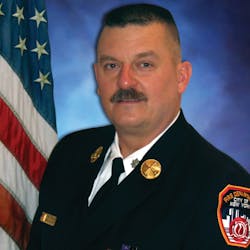The Fire Scene: Volunteer Social Distancing and Training amid COVID-19
Since the arrival of COVID-19, the activities and training regimens of many fire departments changed dramatically. The American public was asked to stay home and to practice social distancing when it was necessary to go to public places. The fire department faced some tough decisions. Career departments still had to staff their facilities and respond to calls, so numerous local procedures were developed to facilitate this new situation.
Volunteer fire departments faced a different set of challenges.
Station actions
Because volunteer firehouses generally aren’t staffed, it appeared that there wasn’t a great risk of firefighters infecting each other or spreading the virus during the periods between alarms. Of course, this turned out to be incorrect, because, although there might not be firefighters actually on duty at a volunteer firehouse, many members spend time at the station to perform all sorts of activities and functions. So, how can this situation be handled?
Some departments established a limit on the number of members who could be inside of the firehouse or in areas in the firehouse at any one time. When observed and enforced, this was a great first step. Additionally, all members were required to wear face masks any time that they entered a fire department facility.
Other fire departments simply “closed” the firehouse for any activity other than to respond to emergency calls. Obviously, company meetings and other social gatherings were put on hold, but a set of procedures needed to be established for responding to alarms.
One department established the following requirements:
- Members who enter the firehouse for a response must wear a face mask
- Apparatus crews are limited to four members (except structural fires)—two members in cab, two members in crew compartment
- All windows on apparatus must be kept open, rain or shine
- On scene, one member, preferably the officer, exits the rig to investigate
- One apparatus responds to each run (except structural fires)
- Either face masks or SCBA are required when entering any structure
- Upon return to the firehouse, members stow their gear, two at a time, and exit the firehouse immediately
Of course, variations on the aforementioned might work better for you.
Still putting in the time
The next important activity to be addressed in conjunction with COVID-19: training. Many volunteer departments conduct training one evening per week, but, again, the restriction on assembling a group inside needed to be observed. Ideas for “outside” training include:
- Assemble members outside, properly distanced. Position apparatus nearby. Officer asks one firefighter to retrieve a specific tool or piece of equipment. This is a test to see that the members know where their equipment is on the rig. When the tool is found, the officer then can talk with and ask questions of the members about the tool. What is it used for? How is it started? What kind of fuel is used? It isn’t hands-on training, really, but at least you can engage the members, and they can learn where all the tools are and how they work.
- In full gear—with or without SCBA—practice hose stretching, for which we never can have enough experience. Again, this can be done right outside of the firehouse or in the parking lot. Various scenarios can be used, such as stretch “a line” to the basketball hoop and then to the dumpster. The members need to select the preconnect that is long enough, stretch properly around objects to the location and call for water. Each element of that evolution is a learning point.
- Position each (all) apparatus in the parking lot and have an officer at each rig demonstrate to a small group how to start and get the rig into pumps or power take off. This process varies on different apparatus, and even though every member isn’t an apparatus driver, this information is valuable and can be reviewed regularly.
Performing our duties during this pandemic is difficult, but it isn’t impossible. Hopefully, the ideas that are presented here will help you to maintain your department’s readiness and to keep your membership sharp and prepared.
About the Author
John J. Salka Jr.
Battalion Chief
JOHN J. SALKA JR., who is a Firehouse contributing editor, retired as a battalion chief with FDNY, serving as commander of the 18th battalion in the Bronx. Salka has instructed at several FDNY training programs, including the department’s Probationary Firefighters School, Captains Management Program and Battalion Chiefs Command Course. He conducts training programs at national and local conferences and has been recognized for his firefighter survival course, “Get Out Alive.” Salka co-authored the FDNY Engine Company Operations manual and wrote the book "First In, Last Out–Leadership Lessons From the New York Fire Department." He also operates Fire Command Training, which is a New York-based fire service training and consulting firm.

